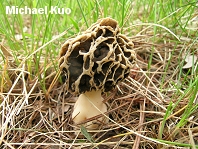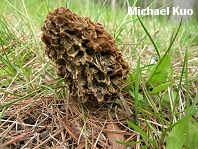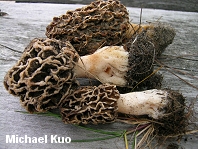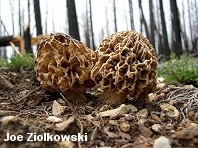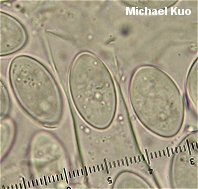| Major Groups > True Morels & Verpas > Morchella prava |

|
Morchella prava [ Ascomycetes > Pezizales > Morchellaceae > Morchella . . . ] by Michael Kuo Cassell's Latin Dictionary (1968) says:
Among the large yellow morels, this odd species looks like an irregular, deformed version of Morchella esculentoides or Morchella cryptica. Its pits are irregular in outline and in arrangement, and the mushroom generally has a gnarled-looking appearance. DNA-verified collections of Morchella prava have come from a wide variety of habitats, from mountain conifer forests to filled-in swimming pools . . . but most of the collections were made in sandy soil near rivers or lakes, under oaks and pines. The distribution of the species appears to be northern, from Montana to Ontario. My friends and I have collected Morchella prava for many years in northern Michigan, along the Straits of Mackinac, often within a few feet of the water. It is an odd and fascinating morel--and it sometimes seems to remain immature, retaining its blackish pits and pale ridges, all the way through its development. Description: Ecology: Possibly saprobic and mycorrhizal at different points in its life cycle; growing alone, scattered, or gregariously under various hardwoods and conifers, often (but not always) in sandy soil near bodies of water (lakes, rivers); April, May, and June; apparently widely distributed in northern North America (DNA verified from Montana to Saskatchewan, South Dakota, Michigan, and Ontario). Cap: 3-6 cm tall and 2-5 cm wide; irregularly shaped but often more or less egg-shaped with a slightly narrowed or widely conical apex; pitted and ridged, with the pits randomly arranged and oriented and irregular in outline; when young with bald or finely velvety, flattened or widely rounded, pale yellowish to whitish ridges and medium to dark gray or black pits; when mature with bluntly rounded to sharp or eroded, brownish yellow to yellowish brown ridges and similarly colored pits (but often remaining in the "gray stage" for a prolonged period and apparently never maturing); attached to the stem directly, without a groove; hollow. Stem: 2.5-4 cm high and 1-3 cm wide; equal above a slightly swollen base; whitish to yellowish; often discoloring reddish brown; bald or nearly so; hollow. Microscopic Features: Spores (16-) 17-21 (-24) x (8-) 10-12 REFERENCES: Dewsbury, Moncalvo, J. D. Moore & M. Kuo in Kuo et al., 2012. (Kuo, 2005; O'Donnell et al., 2011; Kuo et al., 2012.) SPECIMENS EXAMINED: Herb. F. 05249502, 05130306, 06060301, 04220402, 05090401, 05200402, 05270401, 05300403, 05100602 (holotype), 05200601, 05210901. This site contains no information about the edibility or toxicity of mushrooms. |
© MushroomExpert.Com |
|
Cite this page as: Kuo, M. (2012, November). Morchella prava. Retrieved from the MushroomExpert.Com Web site: http://www.mushroomexpert.com/morchella_prava.html. |
